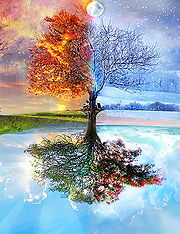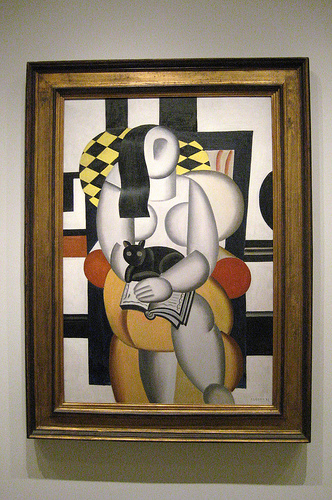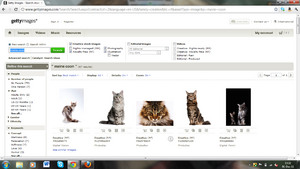Fine Arts
From booktorrent
Contents |
Digital Fine Arts
Throughout most of the early twentieth century visual art and science were generally perceived as two separate and diverse disciplines of study. However, beginning in the early 1970s the two subjects were reconnected with the use of computers, digital photography, "internet art" and software programs all used to create and/or manipulate digital images and multimedia art. The fine arts have been redefined over the last forty years to incorporate digital technology and that has impacted not only the classical arts (e.g. painting and sculpture) but has gone on to create new genres of art. With the use of technology, science and mathematics artist are constantly reinventing what the fine arts looks like. The question then becomes how are research institutions and academic libraries evolving with this ever expanding definition of what the fine arts is today and what it will look like in the future? When faced with reinventing the library in the 1960s Robert S. Taylor had this to say:
"There are moments...when we wish we did not have to use the word 'library.' The word carries too many connotations, which, partially truth and partially myth, may not let the library get to tomorrow, may inhibit its adaptability. The term exaggerates the differences between print and other media. It emphasizes the warehouse rather than the dynamic process. It focuses on the physical objects rather than the people." (qtd. in Walker, 817)
These words ring true today. As libraries attempt to transform themselves into an environment that accommodates the digital world one aspect to consider is the importance behind what features will be most beneficial to the people that said library is evolving for. For the digital fine arts the most important aspect in academia is access to information and imagery. That being said, databases, digital preservation systems and software each play a crucial role when creating a strong digital fine arts department.
Digital Visual Fine Arts
Two pivotal genres exist in the academic world of digital visual arts. First being born-digital fine arts which is art created using digital software or multimedia for digital display and the second being digitized pieces of art which would be classic images such as paintings, sculptures and drawings that have been reproduced in a digital or sometimes virtual format. The latter of the two being the most controversial, as many argue that a virtual or digital image of a classical piece (a) diminishes the arts uniqueness and (b) prevents its viewer from capturing a real sense of the 'aura' of the piece. (Vaughan, 6) As technology improves it could be argued that the uniqueness of the image could eventually be captured, though the argument of the 'aura' may always be a controversial one. However, more and more museums today are creating virtual models of themselves that can be accessed online and would allow patrons a tour through its building and a chance to see its collections. One such museum is the Smithsonian: http://www.mnh.si.edu/panoramas/#
Art On The Internet VS Internet Art
Internet art is a somewhat controversial form of art that has evolved from very basic web pages that 'performed' into what has become digital images that interact with users. It can often be misinterpreted or simply confusing to its viewer. In her essay, "Net.art and Net.pedagogy: Introducting Internet Art to the Digital Curriculum, Alison Colman had this to say about the difference between art on the internet and internet art:
"There is an enormous amount of art reproduced on the Internet due to the computer's ability to replicate any reproductive medium. This "art on the 'Net' can be described as an image that has been created with another medium, scanned into a computer, and displayed on the web...art on the 'Net' treats the internet as a virtual gallery [whereas]...Internet art is created specifically for the online environment." (62)
Image databases are home to much of the art on the internet, however, internet art would be constructed using its own website thus the entirety of the link or website would be considered the art piece. Some examples of internet art are:
http://www.intotime.com/ by Rafael Rozendaal
http://www.constantdullaart.com/ by Constant Dullaart
http://www.fromthedarkpast.com/ By Rafael Rozendaal
When discussing internet art in her book, Internet Art, Rachel Greene wrote that "[i]nternet art is part of a continuum within art history that includes strategies and themes as instructions, appropriation, dematerialization, networks and information." (pg. 8-9). That is to say that internet art, however unpopular or controversial, has now become a crucial genre in the history of all art. That being said I argue that internet art, though perhaps not now, will one day be considered fine art. Internet art is has and evolved developed drastically over the past several years. It has become a cultural phenom that has gained mainstream and media attention, thus, it is contributing socially in public and private spheres. (Stallabrass, 9).
Art History & The Digital World
Art history or 'Visual Culture' as it is becoming more frequently referred to due to the fact that the latter is a "term that simultaneously obviates both history and art, replacing these with a temporarily unspecific and aesthetically non-discriminatory exploration of the pictorial," (Vaughan, 4) is perhaps undergoing one of the more complicated transformations in academia due to digital imagery of the fine arts. While many art historians (and for obvious reasons many publishers) are arguing that the aforementioned 'aura' of an art piece is lost with digital imagery and thus ill-suited for the classroom, many others are taking advantage of virtual museums, image databases and the volumes of critical writings now available via the internet from research institutions and libraries around the world. These historians are collaborating with other academics in ways that hasn't been possible in the past to create a new form of dialogue about any given piece of art.
During a conference held in 2006 at the Getty Research Institute (GRI) in Los Angeles Thomas Moritz, associate director and chief of knowledge management at GRI, claimed that "digital technologies have the potential to deepen and enrich traditional scholarship and may enable entirely new lines of research (Baca, Tronzo, 52).
However, it goes without question that many art historians and academic teachers are avoiding the use of image databases due to their lack of information. Though the databases have a large volume of images these images are lacking a context from which they came and thus have proven to be partially ill-suited for research means. Art historians argue that image databases need to better serve the field of art history and not just collect images because they exist. The Most essential way to accomplish this is At a conference held at the Getty Research Institute Max Marmor, director of collection development for ARTstor, had the following to say:
"It is essential to focus first and foremost on relationships and on what creators (artist, photographers, et al.) and collecting institutions (archives, libraries, museums) have in common with educators, scholars and other users of digital resources." (Baca, Tronzo, 54).
I believe Marmor is mentioning the importance of these relationships because the users of the digital image databases are trying to procure a sense of the history of the art piece they are researching and for that to happen successfully the 'creator' of the art must have some say in the context in which their art is being reproduced.
New Media Art Preservation
New Media Art Preservation is the study and practice of conserving digital art from the past and the present while preparing for the art to come in the future. Scholars of this field are working with technology that is constantly evolving thus making it difficult to reproduce images that were created using outdated software and/or hardware. In a panel discussion at the Getty Research Institute Clint Hope, executive director of Experimental Systems/Applied Minds had this to say about preserving Digital Art:
"Our biggest fear is that we are deep in a dark age where all of the digital information is going to be lost. We will have the books and prints from the past and something will evolve in the future, but our present digital history will be gone. The digital data put on the early internet is gone. We have the archival digital masters, and there no longer exist machines that can read them." (Baca, Tronzo, 51)
It is out of this realization that the study of New Media Art Preservation came into fruition. It became and continues to be important to establish a universal technological vocabulary that could break down the software used by the artist in order to later reproduce a digital art piece with different hardware or more advanced programming while still maintaining the essence of the original piece. For example, in his essay, "The Media Art Notation System: Documenting and Preserving Digital/Media Art," Richard Rinehart compares the system he created, the Media Art Notation System (MANS), to that of a musical score. Rinehart argues that "[m]edia art has variable form, much like music. A single musical work can be performed using different instruments or hardware each time." (Rinehart, 181) Rinehart goes on to suggest that the authenticity of the score of music is never lost even when reproduced through different mediums and the same should hold true for digital/media art. If the same were true for digital art it would mean there would be some sort of notation system created of symbols and codes and could be read similarly to that of music by a computer in order to reproduce an older digital image.
When discussing the future of digital art preservation during a panel discussion at the Getty Research Institute Joanna Stevens, vice president for corporate communications at Yahoo, "[w]e should develop technology that can be degraded to recover images and display them with the technology of the future." (Baca, Tronza, 53) In other words, Stevens is arguing that as we develop technology used for preserving digital art we should constantly keep in mind that we want not only to preserve the art of the now, but that we should "make room in image-archiving techniques for higher-resolution displays, expanded color gamuts and additional data." (Baca, Tronzo, 53) By "making room" we would be making it possible to reproduce or recreate the digital art of today while using the software and hardware of tomorrow.
Image Databases
When using an image database it is easy to appreciate the search engine as one can type the name of an artist and receive hundreds of thousands of digital images within seconds in the same manner one can use content-based image retrieval (CBIR) which is typing in a descriptive detail of the image into the search engine (e.g. color, shape, etc.). However, as Max Marmor, director of collection development for ARTstor pointed out during a discussion at the Getty Research Institute, "what we do lack are digital collections that have the features we most value in libraries--features designed to support teaching, learning and research" (Baca, Tronzo,54). What Marmor is arguing is that though the image databases provide a significant amount of images and give details about the image itself there is a lack of academic writings, scholarly work and critical essays provided with the image. An image database in academia should be able to provide a well rounded volume of information for any particular image.
During an interview with Professor Hugh Lentz from The Evergreen State College, Lentz stated that he rarely if ever uses image databases as he believes that images are often take out of context. (interview Lentz, 2011). I would argue that Lentz's dislike of the image databases is similar to that of many art historians dislike for them. The databases do not provide enough information about a particular image and do not allow the viewer to become more educated on what it is that is being displayed.
Examples Of Image Databases
The Art Institute of Chicago: http://www.artic.edu/aic/
Artcyclopedia: http://www.artcyclopedia.com/index.html
ARTstor: http://www.artstor.org/index.shtml
Camio: http://0-camio.oclc.org.cals.evergreen.edu/
Euromuse: http://www.euromuse.net/
The Google Art Project: http://www.googleartproject.com/
The Library of Congress: http://memory.loc.gov/ammem/index.html http://www.loc.gov/pictures/
The Metropolitan Museum of Art: http://www.metmuseum.org/
The National Gallery of Art: http://www.nga.gov/
Smithsonian American Art Museum: http://www.americanart.si.edu/
Visual Arts Data Service: http://www.vads.ac.uk/
Visual Collections: http://www.davidrumsey.com/collections/
Bibliography
Baca, Murtha, and William Tronzo. "Art History and the Digital World." Art Journal 65.4 (2006): 51+. JSTOR. Web. 20 Oct. 2011.
Colman, Alison. "Net.art and Net.pedagogy: Introducing Internet Art to the Digital Art Curriculum." JSTOR. National Art Education Association, 2004. Web. 11 Nov. 2011.
Drucker, Johanna. Sweet Dreams: Contemporary Art and Complicity. Chicago: University Of Chicago, 2005. Print.
Greene, Rachel. Internet Art. London: Thames & Hudson, 2004. Print.
Lentz, Hugh. "A Conversation with Professor Hugh Lentz." Personal interview. 17 Nov. 2011.
Rinehart, Richard. "The Media Art Notation System: Documenting and Preserving Digital/Media Art." Leonardo 40.2 (2007): 181+. JSTOR. Web. 16 Oct. 2011.
Simanowski, Roberto. Digital Art and Meaning: Reading Kinetic Poetry, Text Machines, Mapping Art, and Interactive Installations. Minneapolis: University of Minnesota, 2011. Print.
Stallabrass, Julian. Internet Art: the Online Clash of Culture and Commerce. London: Tate, 2003. Print.
Vaughan, William. "Introduction: Digital Art History?" Introduction. Digital Art History. Bristol: Intellect, 2004. 1-13. Print.
Walker, Diane Parr. "Music in the Academic Library of Tomorrow." Notes 59.4 (2003): 817-27. Print.
Ward, Annette A., Margaret E. Graham, and K. J. Riley. "Enhancing a Historical Digital Art Collection: Evolution of Content-Based Image Retrieval on Collage." JSTOR. JSTOR, 2004. Web. 20 Oct. 2011. <http://site.ebrary.com/lib/evergreen/Doc?id=10078137&ppg=112>




